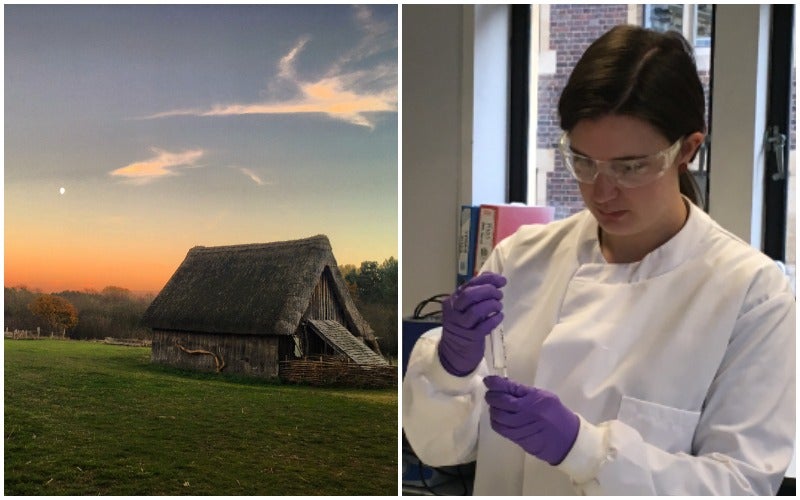Anglo-Saxon kings ‘were mostly vegetarian’, before the Vikings new study claims
Peasants treated rulers to huge barbecues, according to a pair of Cambridge studies

Very few people in England ate large amounts of meat before the Vikings settled, and there is no evidence that elites ate more meat than other people, a new study suggests.
And a sister study argues that peasants would host lavish meat feasts for their rulers instead of giving food as an exploitative tax.
Historians have long assumed royals and nobles ate far more meat than the rest of the population and that free peasants were forced to hand over food to sustain their rulers throughout the year in an exploitative system known as feorm or food-rent.
But a pair of Cambridge co-authored studies published today in the journal Anglo-Saxon England present a very different picture, one which could transform our understanding of early medieval kingship and society.
Bioarchaeologist Sam Leggett analysed chemical signatures of diets preserved in the bones of 2,023 people buried in England from the 5th to the 11th centuries. Her research revealed no correlation between social status and high protein diets.
Her research intrigued historian Dr Tom Lambert at Sidney Sussex College because so many medieval texts and historical studies suggest that Anglo-Saxon elites did eat large quantities of meat.
The pair began working together and investigated a food list compiled during the reign of King Ine of Wessex (c. 688-726) to estimate how much food it records and what its calorie content might have been.
The list included 300 bread rolls so the researchers worked on the basis that one bun was served to each diner to calculate overall portions. Each guest would have received 4,140 kcal from 500g of mutton; 500g of beef; another 500g of salmon, eel and poultry; plus cheese, honey and ale.
The researchers studied ten other comparable food lists from southern England and discovered a remarkably similar pattern: a modest amount of bread, a huge amount of meat, a decent but not excessive quantity of ale, and no mention of vegetables (although some probably were served).
Lambert says: “The scale and proportions of these food lists strongly suggests that they were provisions for occasional grand feasts, and not general food supplies sustaining royal households on a daily basis. These were not blueprints for everyday elite diets as historians have assumed.”
“I’ve been to plenty of barbecues where friends have cooked ludicrous amounts of meat so we shouldn’t be too surprised.”
Leggett adds: “I’ve found no evidence of people eating anything like this much animal protein on a regular basis. If they were, we would find isotopic evidence of excess protein and signs of diseases like gout from the bones. But we’re just not finding that.”
“The isotopic evidence suggests that diets in this period were much more similar across social groups than we’ve been led to believe. We should imagine a wide range of people livening up bread with small quantities of meat and cheese, or eating pottages of leeks and whole grains with a little meat thrown in.”
The researchers believe that even royals would have eaten a cereal-based diet and that these occasional feasts would have been a treat for them too.
These feasts would have been lavish outdoor events at which whole oxen were roasted in huge pits, examples of which have been excavated in East Anglia.
Lambert says: “Historians generally assume that medieval feasts were exclusively for elites. But these food lists show that even if you allow for huge appetites, 300 or more people must have attended. That means that a lot of ordinary farmers must have been there, and this has big political implications.”
Kings in this period – including Rædwald, the early seventh-century East Anglian king perhaps buried at Sutton Hoo – are thought to have received renders of food, known in Old English as feorm or food-rent, from the free peasants of their kingdoms. It is often assumed that these were the primary source of food for royal households and that kings’ own lands played a minor supporting role at best.
But Lambert studied the use of the word feorm in different contexts, including aristocratic wills, and concludes that the term referred to a single feast and not this primitive form of tax. This is significant because food-rent required no personal involvement from a king or lord, and no show of respect to the peasants who were duty-bound to provide it.
Lambert says: “We’re looking at kings travelling to massive barbecues hosted by free peasants, people who owned their own farms and sometimes slaves to work on them. You could compare it to a modern presidential campaign dinner in the US. This was a crucial form of political engagement.”
Subscribe to Independent Premium to bookmark this article
Want to bookmark your favourite articles and stories to read or reference later? Start your Independent Premium subscription today.

Join our commenting forum
Join thought-provoking conversations, follow other Independent readers and see their replies